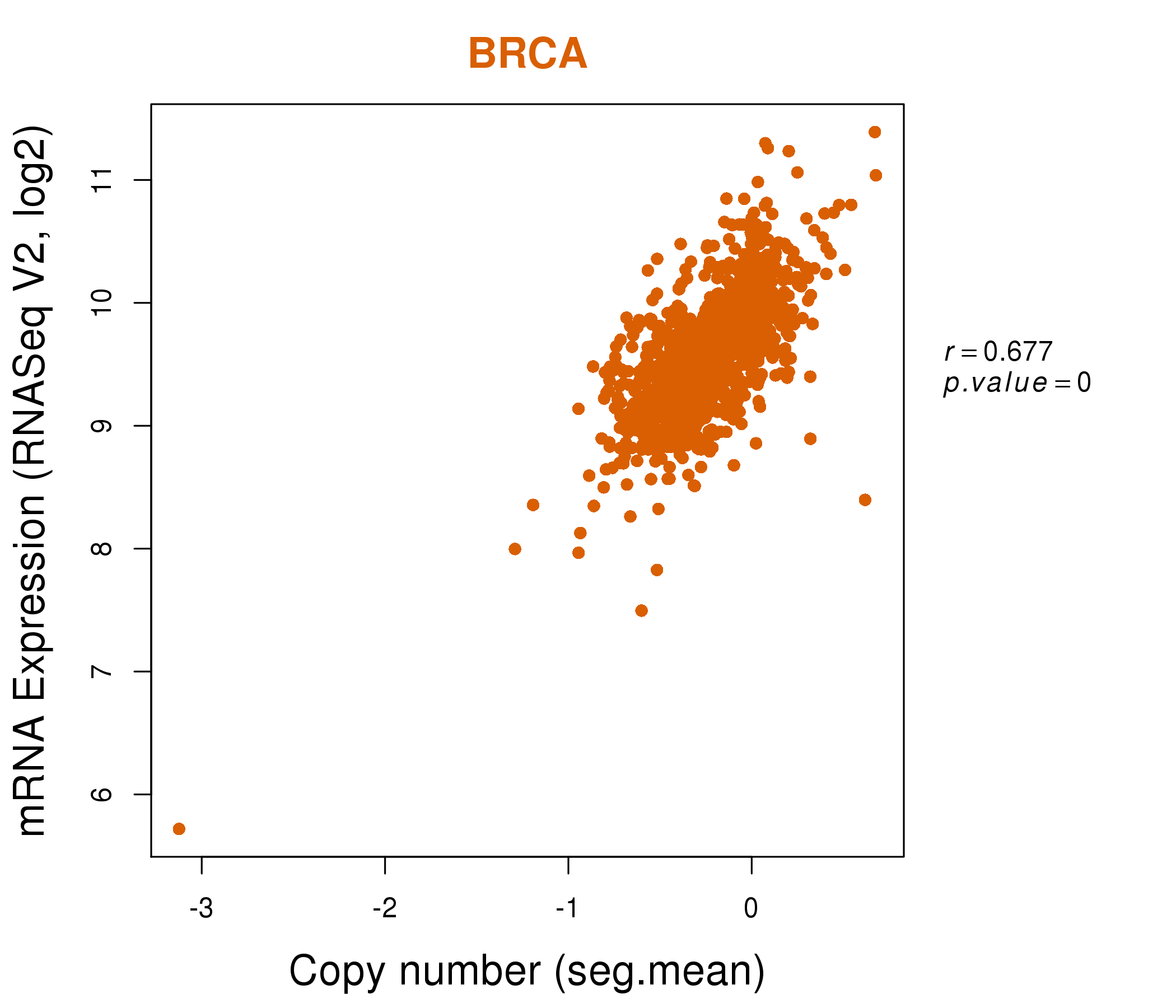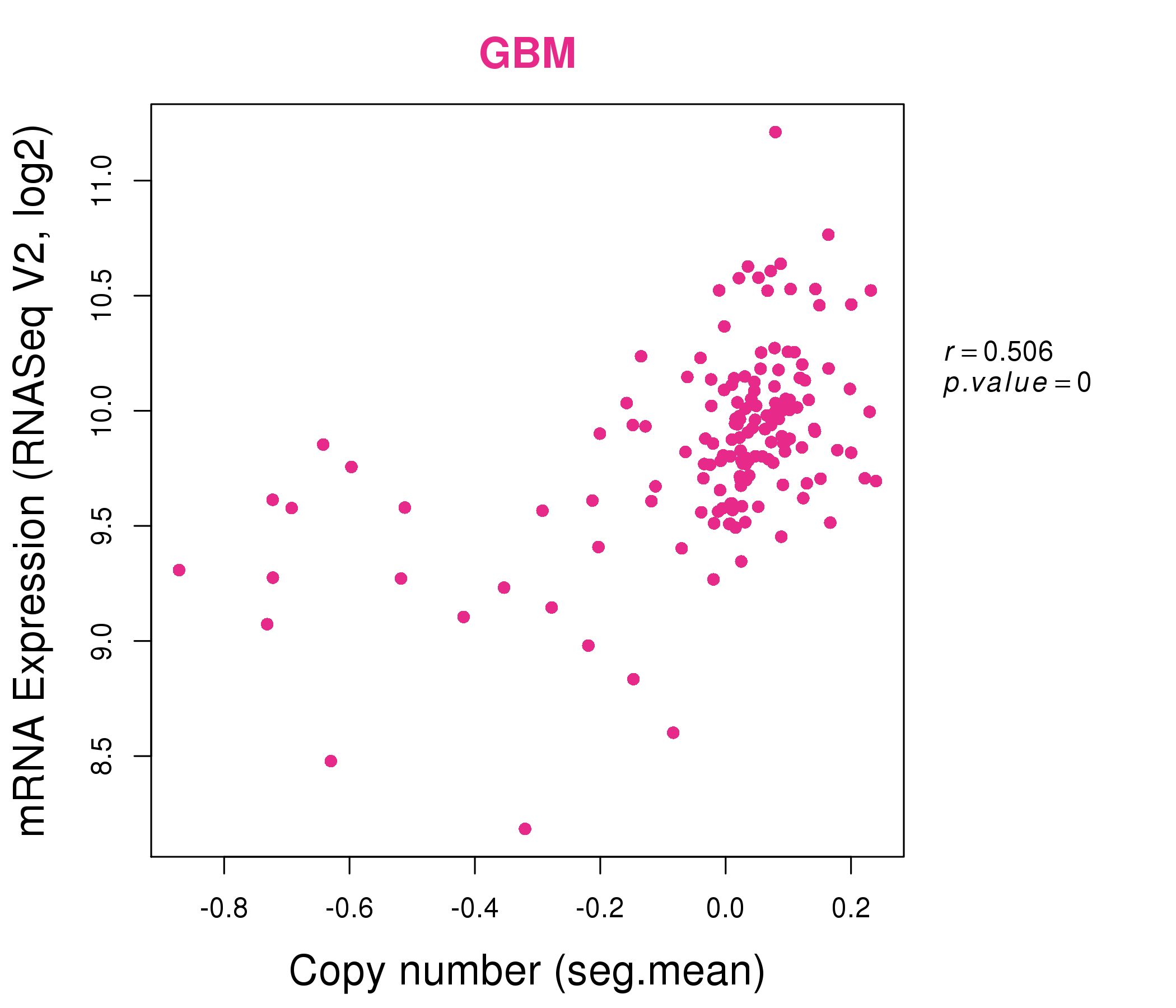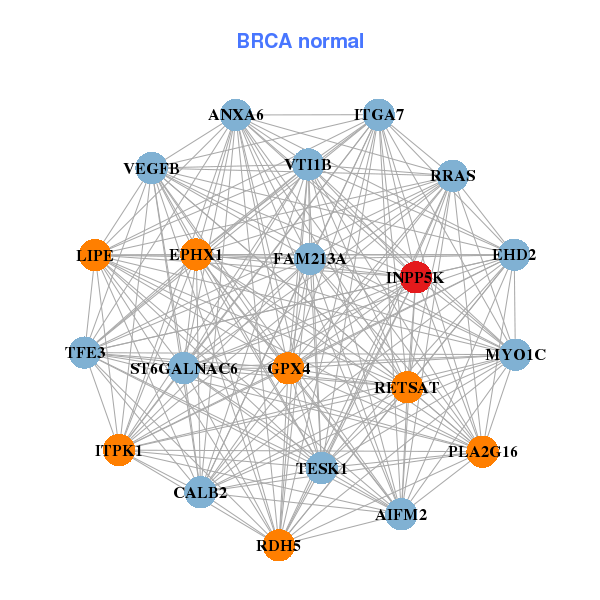|
||||||||||||||||||||
| |
| Phenotypic Information (metabolism pathway, cancer, disease, phenome) |
| |
| |
| Gene-Gene Network Information: Co-Expression Network, Interacting Genes & KEGG |
| |
|
| Gene Summary for INPP5K |
| Top |
| Phenotypic Information for INPP5K(metabolism pathway, cancer, disease, phenome) |
| Cancer | CGAP: INPP5K |
| Familial Cancer Database: INPP5K | |
| * This gene is included in those cancer gene databases. |
|
|
|
|
|
|
| ||||||||||||||
Oncogene 1 | Significant driver gene in | |||||||||||||||||||
| cf) number; DB name 1 Oncogene; http://nar.oxfordjournals.org/content/35/suppl_1/D721.long, 2 Tumor Suppressor gene; https://bioinfo.uth.edu/TSGene/, 3 Cancer Gene Census; http://www.nature.com/nrc/journal/v4/n3/abs/nrc1299.html, 4 CancerGenes; http://nar.oxfordjournals.org/content/35/suppl_1/D721.long, 5 Network of Cancer Gene; http://ncg.kcl.ac.uk/index.php, 1Therapeutic Vulnerabilities in Cancer; http://cbio.mskcc.org/cancergenomics/statius/ |
| KEGG_INOSITOL_PHOSPHATE_METABOLISM REACTOME_PHOSPHOLIPID_METABOLISM REACTOME_PI_METABOLISM REACTOME_METABOLISM_OF_LIPIDS_AND_LIPOPROTEINS | |
| OMIM | |
| Orphanet | |
| Disease | KEGG Disease: INPP5K |
| MedGen: INPP5K (Human Medical Genetics with Condition) | |
| ClinVar: INPP5K | |
| Phenotype | MGI: INPP5K (International Mouse Phenotyping Consortium) |
| PhenomicDB: INPP5K | |
| Mutations for INPP5K |
| * Under tables are showing count per each tissue to give us broad intuition about tissue specific mutation patterns.You can go to the detailed page for each mutation database's web site. |
| - Statistics for Tissue and Mutation type | Top |
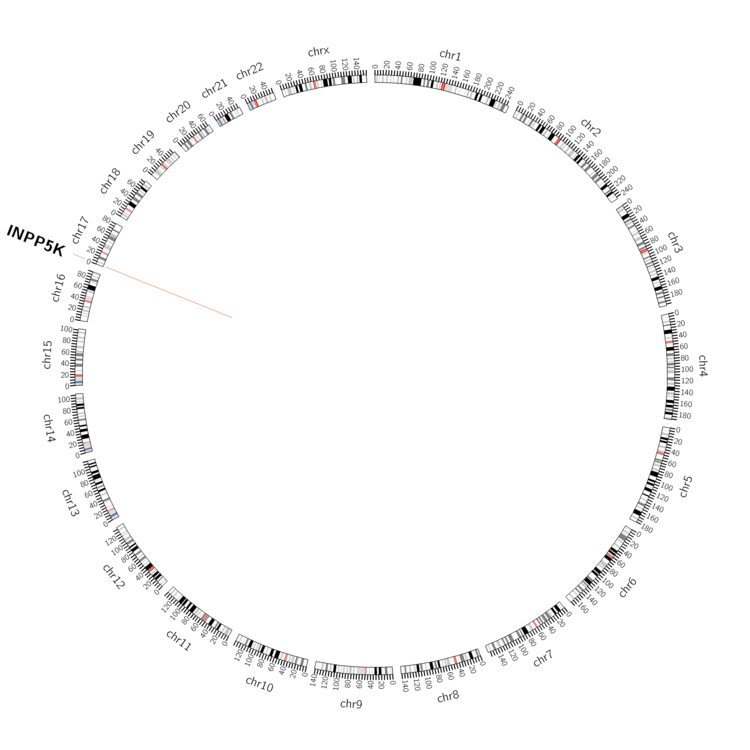 |
| - For Inter-chromosomal Variations |
| There's no inter-chromosomal structural variation. |
| - For Intra-chromosomal Variations |
| * Intra-chromosomal variantions includes 'intrachromosomal amplicon to amplicon', 'intrachromosomal amplicon to non-amplified dna', 'intrachromosomal deletion', 'intrachromosomal fold-back inversion', 'intrachromosomal inversion', 'intrachromosomal tandem duplication', 'Intrachromosomal unknown type', 'intrachromosomal with inverted orientation', 'intrachromosomal with non-inverted orientation'. |
 |
| Sample | Symbol_a | Chr_a | Start_a | End_a | Symbol_b | Chr_b | Start_b | End_b |
| ovary | INPP5K | chr17 | 1398990 | 1399010 | INPP5K | chr17 | 1403057 | 1403077 |
| cf) Tissue number; Tissue name (1;Breast, 2;Central_nervous_system, 3;Haematopoietic_and_lymphoid_tissue, 4;Large_intestine, 5;Liver, 6;Lung, 7;Ovary, 8;Pancreas, 9;Prostate, 10;Skin, 11;Soft_tissue, 12;Upper_aerodigestive_tract) |
| * From mRNA Sanger sequences, Chitars2.0 arranged chimeric transcripts. This table shows INPP5K related fusion information. |
| ID | Head Gene | Tail Gene | Accession | Gene_a | qStart_a | qEnd_a | Chromosome_a | tStart_a | tEnd_a | Gene_a | qStart_a | qEnd_a | Chromosome_a | tStart_a | tEnd_a |
| AI309778 | INPP5K | 1 | 139 | 17 | 1416801 | 1417251 | FBXO34 | 124 | 366 | 14 | 55819178 | 55819420 | |
| Top |
| There's no copy number variation information in COSMIC data for this gene. |
| Top |
|
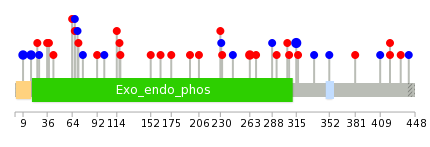 |
| Top |
| Stat. for Non-Synonymous SNVs (# total SNVs=18) | (# total SNVs=17) |
 | 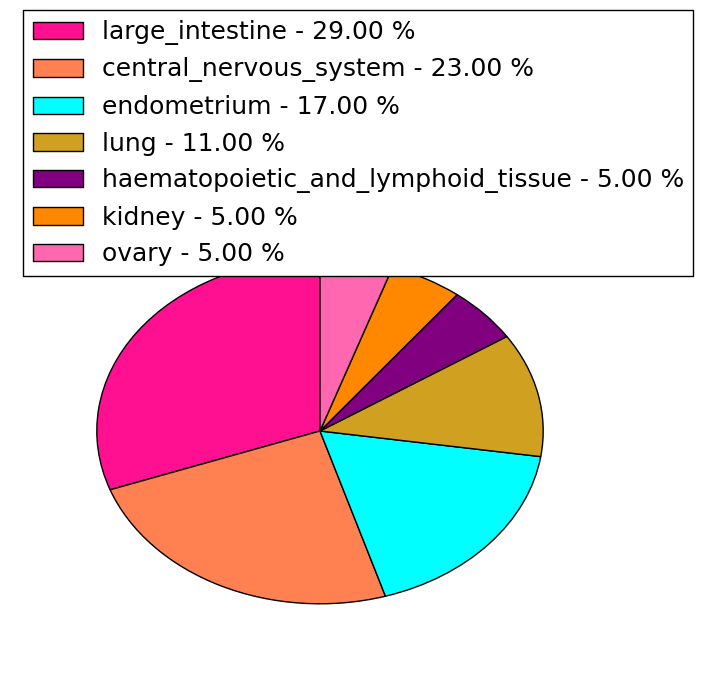 |
(# total SNVs=0) | (# total SNVs=0) |
| Top |
| * When you move the cursor on each content, you can see more deailed mutation information on the Tooltip. Those are primary_site,primary_histology,mutation(aa),pubmedID. |
| GRCh37 position | Mutation(aa) | Unique sampleID count |
| chr17:1401248-1401248 | p.S315S | 3 |
| chr17:1417264-1417264 | p.V18V | 2 |
| chr17:1419767-1419767 | p.P9P | 2 |
| chr17:1401406-1401406 | p.R263C | 2 |
| chr17:1413055-1413055 | p.V100V | 1 |
| chr17:1400056-1400056 | p.P335P | 1 |
| chr17:1417237-1417237 | p.A27A | 1 |
| chr17:1410357-1410357 | p.P231P | 1 |
| chr17:1413080-1413080 | p.R92H | 1 |
| chr17:1401243-1401243 | p.T317M | 1 |
| Top |
|
 |
| Point Mutation/ Tissue ID | 1 | 2 | 3 | 4 | 5 | 6 | 7 | 8 | 9 | 10 | 11 | 12 | 13 | 14 | 15 | 16 | 17 | 18 | 19 | 20 |
| # sample | 11 | 2 | 1 | 1 | 2 | 1 | 2 | 4 | 1 | 4 | ||||||||||
| # mutation | 11 | 2 | 1 | 1 | 2 | 1 | 2 | 5 | 1 | 5 | ||||||||||
| nonsynonymous SNV | 8 | 2 | 5 | 2 | ||||||||||||||||
| synonymous SNV | 3 | 2 | 1 | 1 | 2 | 1 | 1 | 3 |
| cf) Tissue ID; Tissue type (1; BLCA[Bladder Urothelial Carcinoma], 2; BRCA[Breast invasive carcinoma], 3; CESC[Cervical squamous cell carcinoma and endocervical adenocarcinoma], 4; COAD[Colon adenocarcinoma], 5; GBM[Glioblastoma multiforme], 6; Glioma Low Grade, 7; HNSC[Head and Neck squamous cell carcinoma], 8; KICH[Kidney Chromophobe], 9; KIRC[Kidney renal clear cell carcinoma], 10; KIRP[Kidney renal papillary cell carcinoma], 11; LAML[Acute Myeloid Leukemia], 12; LUAD[Lung adenocarcinoma], 13; LUSC[Lung squamous cell carcinoma], 14; OV[Ovarian serous cystadenocarcinoma ], 15; PAAD[Pancreatic adenocarcinoma], 16; PRAD[Prostate adenocarcinoma], 17; SKCM[Skin Cutaneous Melanoma], 18:STAD[Stomach adenocarcinoma], 19:THCA[Thyroid carcinoma], 20:UCEC[Uterine Corpus Endometrial Carcinoma]) |
| Top |
| * We represented just top 10 SNVs. When you move the cursor on each content, you can see more deailed mutation information on the Tooltip. Those are primary_site, primary_histology, mutation(aa), pubmedID. |
| Genomic Position | Mutation(aa) | Unique sampleID count |
| chr17:1401406 | p.R263C,INPP5K | 2 |
| chr17:1417245 | p.G307S,INPP5K | 1 |
| chr17:1401243 | p.S64S | 1 |
| chr17:1412571 | p.F293S,INPP5K | 1 |
| chr17:1417264 | p.L38M | 1 |
| chr17:1401248 | p.A290A,INPP5K | 1 |
| chr17:1413055 | p.A27A | 1 |
| chr17:1419767 | p.P288P,INPP5K | 1 |
| chr17:1401274 | p.S25A | 1 |
| chr17:1413080 | p.R270H,INPP5K | 1 |
| * Copy number data were extracted from TCGA using R package TCGA-Assembler. The URLs of all public data files on TCGA DCC data server were gathered on Jan-05-2015. Function ProcessCNAData in TCGA-Assembler package was used to obtain gene-level copy number value which is calculated as the average copy number of the genomic region of a gene. |
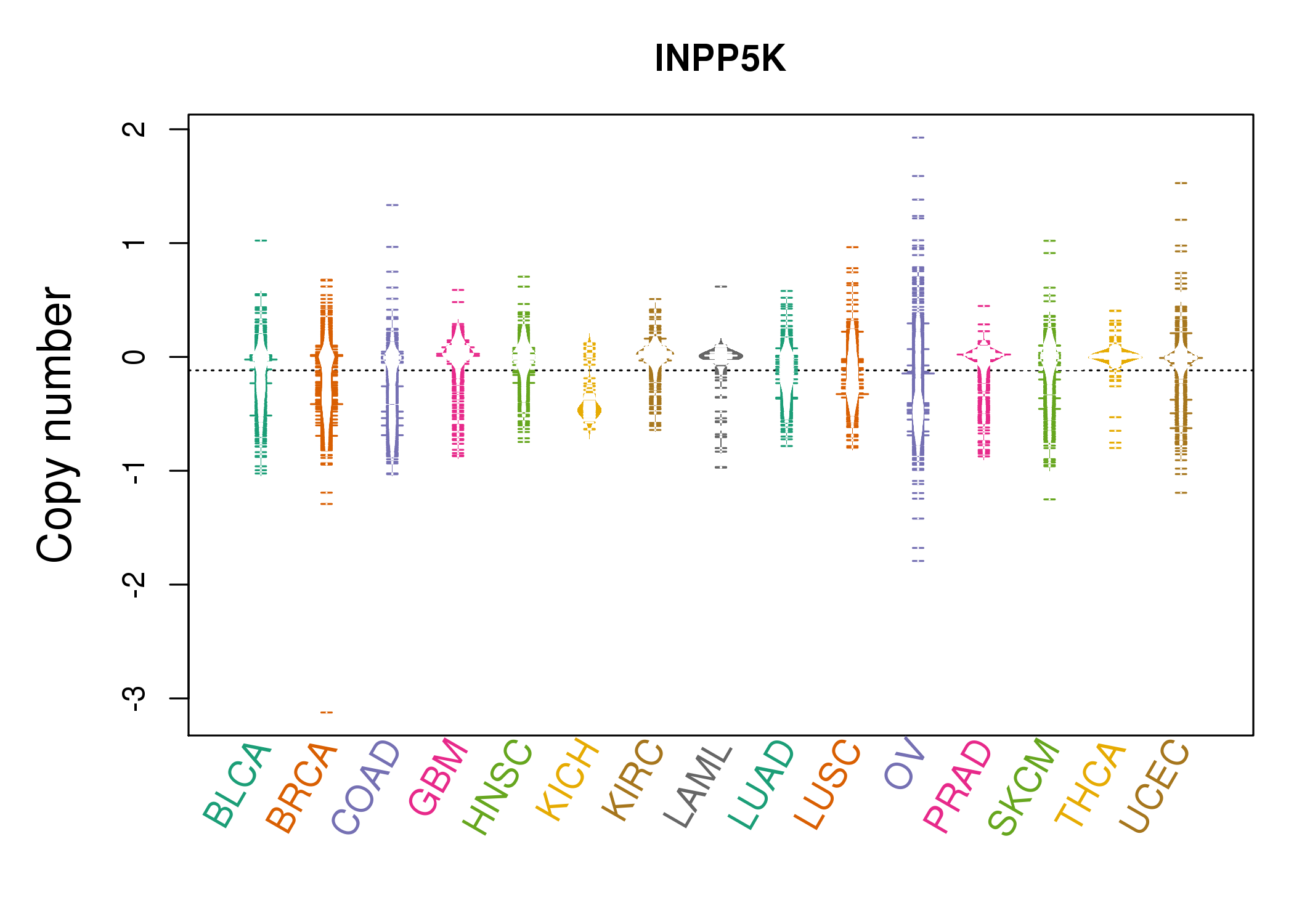 |
| cf) Tissue ID[Tissue type]: BLCA[Bladder Urothelial Carcinoma], BRCA[Breast invasive carcinoma], CESC[Cervical squamous cell carcinoma and endocervical adenocarcinoma], COAD[Colon adenocarcinoma], GBM[Glioblastoma multiforme], Glioma Low Grade, HNSC[Head and Neck squamous cell carcinoma], KICH[Kidney Chromophobe], KIRC[Kidney renal clear cell carcinoma], KIRP[Kidney renal papillary cell carcinoma], LAML[Acute Myeloid Leukemia], LUAD[Lung adenocarcinoma], LUSC[Lung squamous cell carcinoma], OV[Ovarian serous cystadenocarcinoma ], PAAD[Pancreatic adenocarcinoma], PRAD[Prostate adenocarcinoma], SKCM[Skin Cutaneous Melanoma], STAD[Stomach adenocarcinoma], THCA[Thyroid carcinoma], UCEC[Uterine Corpus Endometrial Carcinoma] |
| Top |
| Gene Expression for INPP5K |
| * CCLE gene expression data were extracted from CCLE_Expression_Entrez_2012-10-18.res: Gene-centric RMA-normalized mRNA expression data. |
 |
| * Normalized gene expression data of RNASeqV2 was extracted from TCGA using R package TCGA-Assembler. The URLs of all public data files on TCGA DCC data server were gathered at Jan-05-2015. Only eight cancer types have enough normal control samples for differential expression analysis. (t test, adjusted p<0.05 (using Benjamini-Hochberg FDR)) |
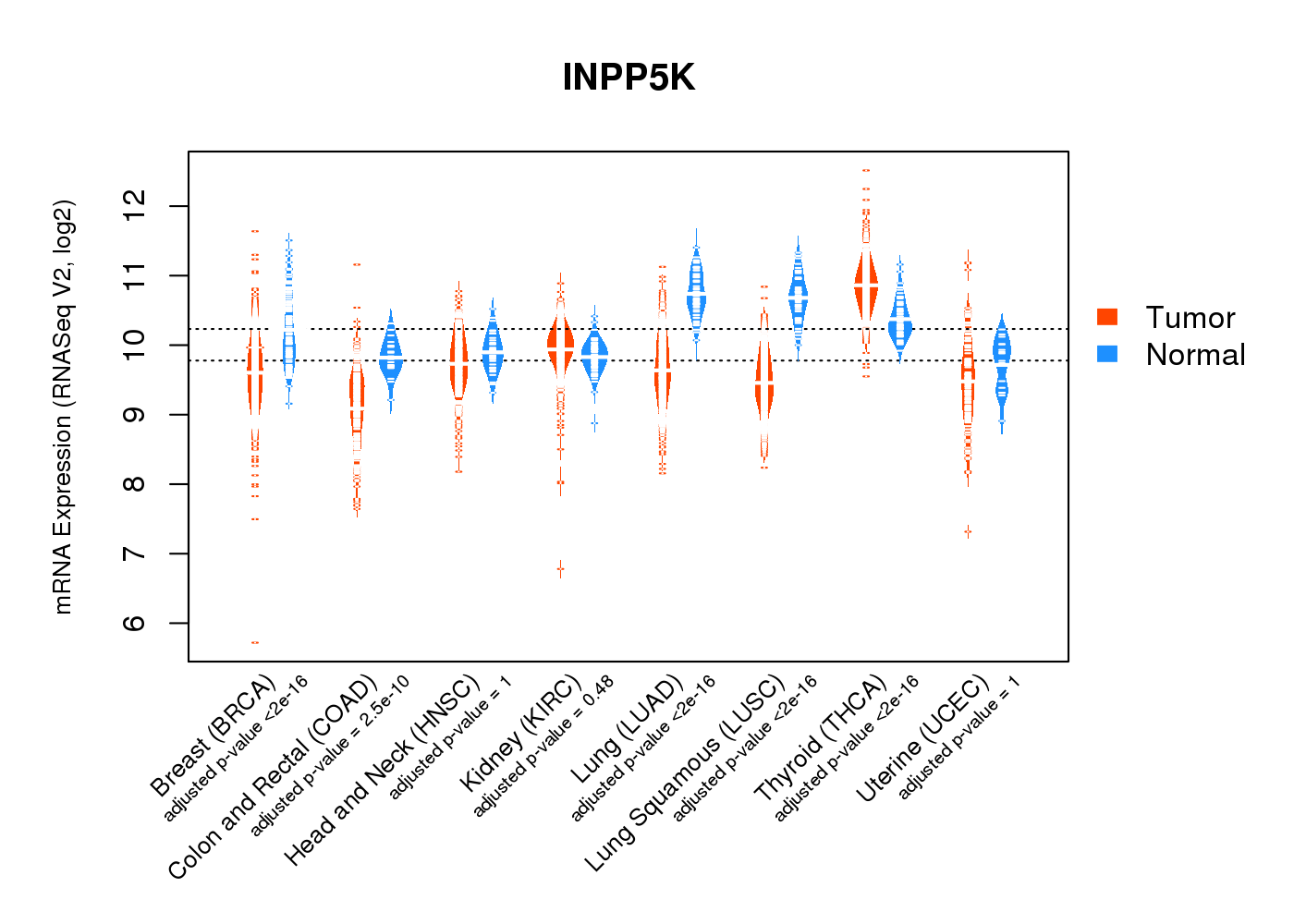 |
| Top |
| * This plots show the correlation between CNV and gene expression. |
: Open all plots for all cancer types
 |
|
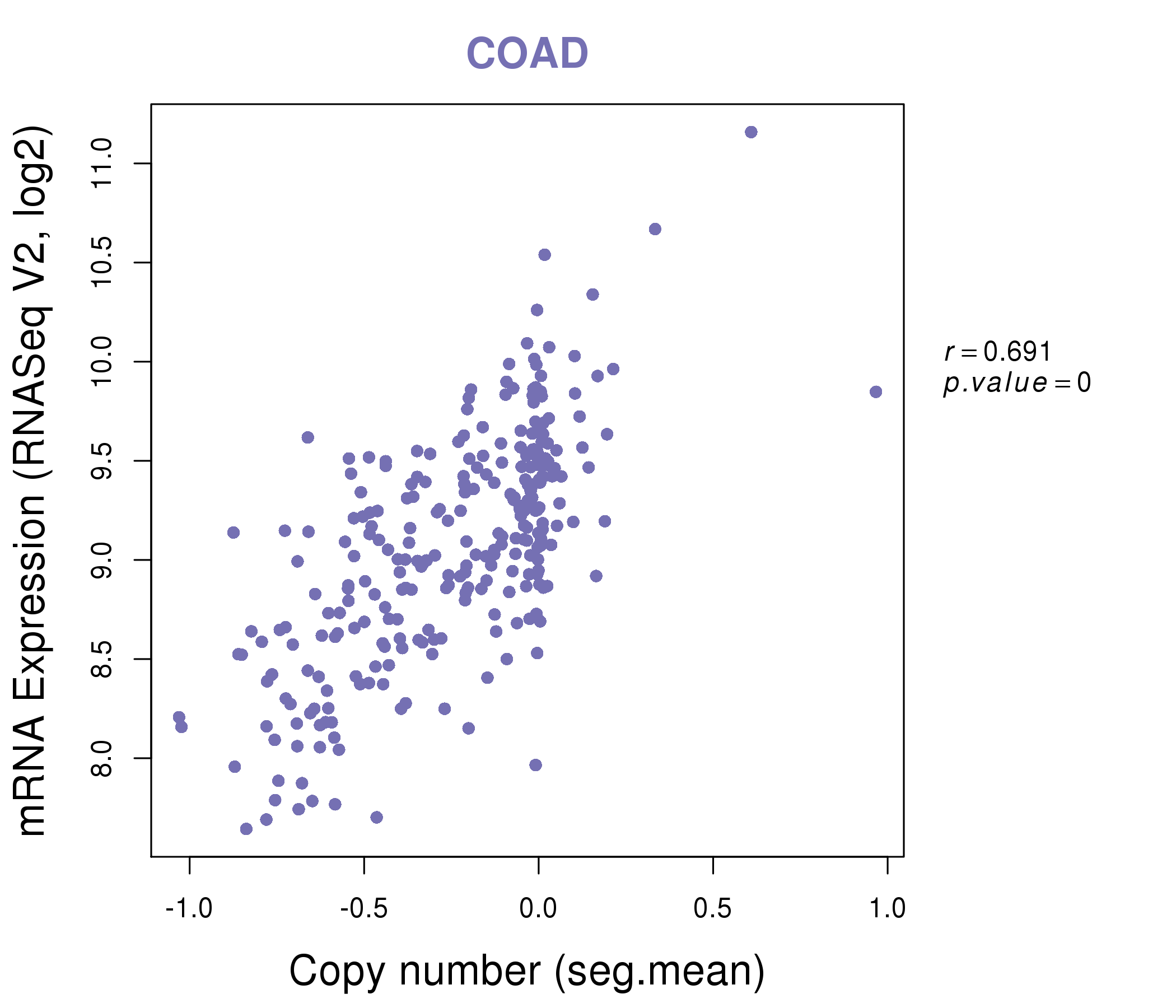 |
|
| Top |
| Gene-Gene Network Information |
| * Co-Expression network figures were drawn using R package igraph. Only the top 20 genes with the highest correlations were shown. Red circle: input gene, orange circle: cell metabolism gene, sky circle: other gene |
: Open all plots for all cancer types
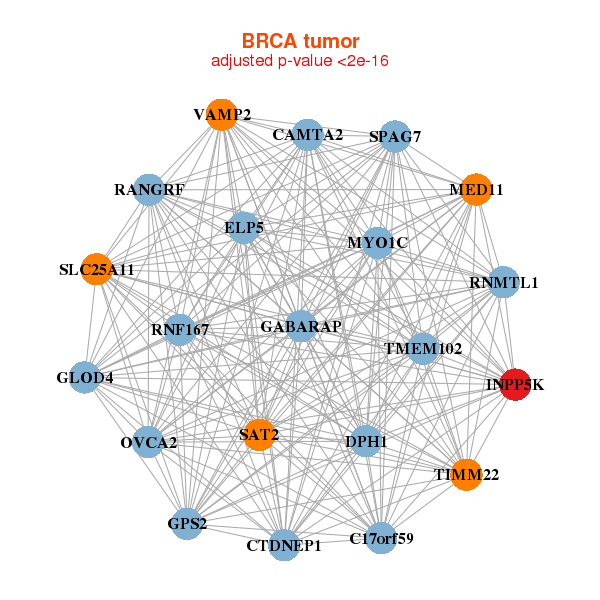 |
|
| C17orf59,ELP5,CAMTA2,DPH1,CTDNEP1,GABARAP,GLOD4, GPS2,INPP5K,MED11,MYO1C,OVCA2,RANGRF,RNF167, RNMTL1,SAT2,SLC25A11,SPAG7,TIMM22,TMEM102,VAMP2 | AIFM2,ANXA6,FAM213A,CALB2,EHD2,EPHX1,GPX4, INPP5K,ITGA7,ITPK1,LIPE,MYO1C,PLA2G16,RDH5, RETSAT,RRAS,ST6GALNAC6,TESK1,TFE3,VEGFB,VTI1B |
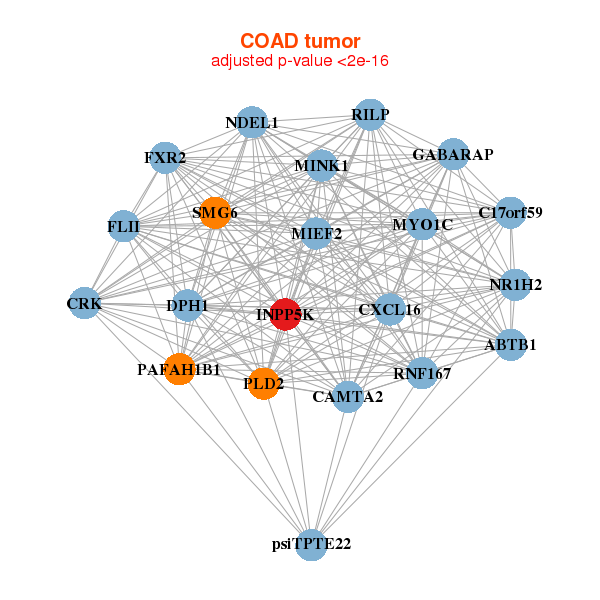 |
|
| ABTB1,C17orf59,CAMTA2,CRK,CXCL16,DPH1,FLII, FXR2,GABARAP,INPP5K,MINK1,MYO1C,NDEL1,NR1H2, PAFAH1B1,PLD2,psiTPTE22,RILP,RNF167,MIEF2,SMG6 | ACOT8,ASB13,B3GALT4,B3GNT8,KDF1,C2orf68,CTDSP1, CTSD,FAM134A,FCGRT,GPATCH3,INPP5K,KLC4,LCMT1, MKNK2,MPND,OAF,PMM1,PRRG2,USP30,VIPR1 |
| * Co-Expression network figures were drawn using R package igraph. Only the top 20 genes with the highest correlations were shown. Red circle: input gene, orange circle: cell metabolism gene, sky circle: other gene |
: Open all plots for all cancer types
| Top |
: Open all interacting genes' information including KEGG pathway for all interacting genes from DAVID
| Top |
| Pharmacological Information for INPP5K |
| There's no related Drug. |
| Top |
| Cross referenced IDs for INPP5K |
| * We obtained these cross-references from Uniprot database. It covers 150 different DBs, 18 categories. http://www.uniprot.org/help/cross_references_section |
: Open all cross reference information
|
Copyright © 2016-Present - The Univsersity of Texas Health Science Center at Houston @ |






